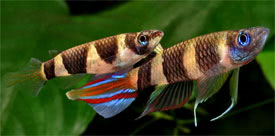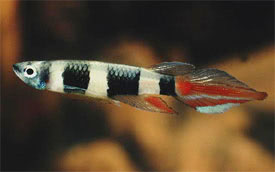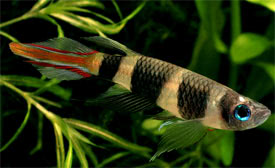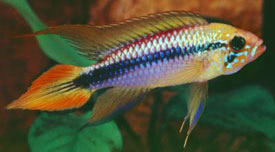
 Magyarul / Hungarian
Magyarul / Hungarian



- Scientific name: Epiplatys annulatus
- Synonyms: Aplocheilus annulatus, Haplochilus annulatus, Panchax annulatus, Pseudepiplatys annulatus
- Common name: Clown Killifish, Rocket Panchax, Banded panchax
- Group: Killifish
- Habitat: Africa; Guinea, Liberia and Sierra Leone
- Size: 4 cm
- Biotope: Inhabits in coastal swamps and shallow waters of the coastal areas.
- Social behavior: A very peaceful and shy fish. Can be kept in a community tank with small characins and rasboras. Keep in mind, that they will easily be outcompeted by more vigorous fish. They swim just below the surface.
- Diet: Carnivorous; only accepts small live foods, like cyclops, artemia and grindal worms.
- Breeding: Quite hard
- Tank: Minimum 30 litres
- Population: 1 male and 2-3 females for 40 litres
- Decoration: Use dark substrate (peat), and plant the tank densely, with a cover of floating plants to diffuse the light. The fish is an excellent jumper so the cover must be very tight fitting. A long, low tank with a lot of surface area is preferable.
- Temperature: 24-26 °C
- pH: 5-7
- Hardness: 2-12 NK°
- Lifespan: 3-5 years
Description: Clown Killifish is an elongated fish with an up-turned mouth. Coloration is variable, both sexes are cream colored with four wide black bands beginning just behind the head. The male is the larger, with brightly colored fins, and with longer caudal, dorsal and anal fins. On female the caudal fin alone is colored and the body lacks th ered color of the male. The dorsal fin in males can be cream colored, pale red, or even bright blue. In females, the dorsal fin is clear. The caudal fin is pale to sky blue in males with the middle extended rays being bright red. In some variants, this red can be a orange, or yellow with bright red lines above and below. The anal fins of males can be blue, red, or the mix of these two depending on the variant. Females have usually clear anal fins. Unlike many other killifish species, it is usually found in bodies of permanent water and is not an annual species.
Breeding is difficult. Recommended soft, moderately acid water (1-3 dGH° and pH 5-5,5) at a temperature about 25-26 °C. Since the fish are „egg-hangers” use fine-leaved plants or perlon webbing as spawning material. Peat filtration is beneficial. The fish should be conditioned on a varied diet of live foods before spawning. A pair in top condition may spawn daily, for a period of about 2 weeks. Each pair should only be allowed to spawn for a week as they become weak during spawning (especially the female). Collect the eggs regularly, and place them into a.small container. 1-3 drops of methylene blue should be added to the water. The eggs require 8-10 days to develop. Feed the fry with infusoria, as they are very tiny. After a few days the fry can be fed with small Brine Shrimp nauplii. The fry should initially be kept in very shallow water but the level can be raised as the fry grow. The young grow slowly.
There is another method of breeding Epiplatys annulatus. Simply plant a large (at least 80 litres) tank as densely as possible, and add a group of adult fish. Since the parents will not disturb the eggs, the adults can remain in the breeding tank. Some fry will survive and a viable population can be built up this way.





































